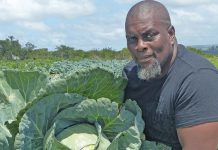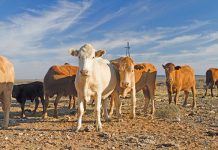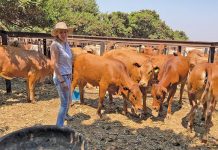
The Dané Dexter stud is a real family concern run by Danie Jansen van Vuuren, his wife Carina and their three children on their 4 521ha farm Orpheus. “The animals’ stable temperament and small size means that the children can take an active part in the day-to-day management of the stud,” says Carina. In a diverse farming business, the family also run a trophy hunting business, a commercial Simmentaler and Brahman cross-bred herd, a grey Brahman stud, a Damara sheep stud and commercial Boer goat and sheep flocks.
Opportunity
In 2007 the Jansen van Vuurens visited the Windhoek Show where they saw Dexter cattle for the first time. Impressed with the “compact but robust little animals”, they took a hard look at the qualities of the breed, saw the economic potential in the animals and decided to establish a Dexter stud.

Danie and Carina Jansen van Vuuren with their children Franco (3) Danie (7) and Chané (6).
Carina explains how they started: “We bought a bull and a heifer in 2008 from the Sacwitz Dexter Stud near Maltahöhe.”
They were impressed by the breed’s hardiness, excellent carcass quality and exceptional milk production. Danie soon found that the demand for Dexters in Namibia was growing rapidly. The husband and wife team are now the chairperson and secretary of the Namibian Dexter Breeders’ Society.
Dexters thrive on the veld
Although Dexters are small animals, Danie says they thrive on the savannah type veld in their area, dominated by mopani trees and Bushman grass. “They are strong foragers and cope well with extensive grazing conditions.” Conditions are demanding with a carrying capacity on Orpheus of about 14ha/ MLU (two Dexters = 1MLU) and an average annual rainfall of about 300mm. The cattle have access to a protein lick in winter and a phosphate lick in summer.
Management
Bull calves and young heifers are separated and the rest of the 65-strong herd is rotated in five camps of between 60 ha and 150ha each. The stud consists of four stud bulls, six young bulls, 25 breeding cows, 10 heifers and 20 calves. “Birth weights average between 20kg and 24kg, but we have recorded weights of up to 28kg and some as low as 9kg. Weaner weights at 8 months vary from 140kg to 150kg, underscoring the excellent feed conversion and growth rate. We maintain a calving percentage of between 80% and 90%. ”
Cows and heifers close to calving are kept in a smaller camp near the homestead so that calving can take place under the supervision of the family. After calving, cows and calves are kept close for another two months so that some protection from predators such as jackal, hyena, leopard and cheetah is provided. “As we are building our herd, we run selected breeding bulls year-round with the female animals,” Danie explains. “This means that we always have cattle available to sell.
“It is our mission to contribute to the country’s small Dexter gene pool. In 2004 there was only one Dexter breeder in Namibia. Now there are nine who represent 313 registered animals. There is such a demand for Dexter breeding material that we plan to grow our herd to 100 animals as fast as we are able to.” Dexters are popular with people on small farms and smallholdings as they require relatively little upkeep and are a good choice for milk and meat for a household with little access to land says Danie. “Because of its size and sweet temperament, the Dexter is also popular with female farmers,” Carina adds.
Dual purpose breeding
“The Dexter has a higher proportion of saleable meat for its body weight than most beef breeds. A Dexter cow can produce up to six times its body weight in milk during a single lactation, even in extensive conditions,” says Danie. They add that Dexter beef is well marbled, tender and has an excellent texture. “Some Namibian butcheries are prepared to pay a premium of R2/kg above the going beef price for Dexter beef. The rib eye muscle relative to body weight is significantly larger in the Dexter than in most other breeds, giving a higher proportion of saleable meat,” adds Danie.

The river provides a watering point for the Jansen van Vuuren’s Dexters on Orpheus farm, in the Outjo district of northern Namibia.
The Jansen van Vuurens breed dual purpose, medium-framed Dexters and the Dané Stud selection criteria include fertility, udder quality, temperament and femininity in the females. Bulls are selected for temperament, conformation and masculinity. “It makes economic sense for us to run a stud herd as it takes virtually the same input and effort to raise stud cattle as it does to run commercial cattle, but far higher prices are realised for stud animals.”
Easy care
Danie explains that production costs in their area are relatively low. One of the reasons for this is that the hot, dry climate keeps pests and diseases to a minimum. “We inoculate our cattle against anthrax, botulism, black quarter, and brucellosis. Ectoparasites are spot treated with Deadline when tick loads are heavy.”
Determination
Danie admits that it took perseverance to develop the stud from scratch. Especially as they suffered a serious loss when their top stud bull, Dané Henk, died suddenly in 2012. The bull was bred in the stud in 2009 and showed tremendous potential. “We put our hope on him as a future stud sire, but never collected his semen as he was so young. He died shortly before the 2012 Windhoek Show. Fortunately, he had already sired a few bull calves which we have kept.”
One of Dané Henk’s daughters, Dané Julani, was Interbreed Dual Purpose Champion Heifer at the 2012 Windhoek Show.
“His son, Dané Blackie, was the Dexter Bull Calf Champion at the 2012 show so the genetic material we lost with his death was not altogether lost,” says Carina.
The couple predicts a bright future for the breed. “Considering the increasing demand for Dexters, it seems that the breed is set to grow significantly in the future,” says Danie. “The sky is the limit as long as Namibian stud breeders can supply quality animals and expand the gene pool. I look forward to the day we start exporting animals to South Africa.”
Contact Danie Jansen van Vuuren at [email protected] or on +264 81 255 7554.













